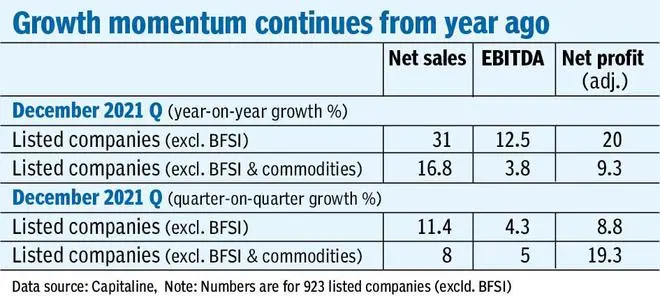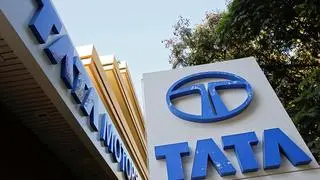Corporate India delivered yet another strong performance in the December 2021 quarter.
Overall, India Inc. reported a year-on-year (y-o-y) 31 per cent rise in net sales, 12.5 per cent in EBITDA (earnings before interest, taxes, and depreciation) and 20 per cent in adjusted net profit in the December 2021 quarter or Q3 FY22 compared to the same period last year. The analysis is based on the financials of 1,220 listed companies excluding BFSI, that had declared results until February 9.
.A large part of India Inc.’s performance surge has been driven by commodity companies thanks to the rally in commodity prices over the past year. The Refinitiv / CoreCommodity CRB Index, an indicator of key global commodity prices, went up as much as 38 per cent between December-end 2020 and 2021.
Operating costs up, others down
Rise in raw material expenditure, which was the single largest cost component, bumped up overall operating expenses for the selected companies. This was despite lower spend on employee costs and other expenses. As a percentage of sales, raw material cost rose to 36 per cent in Q3 FY22 from 32 per cent a year ago. On the other hand, a combination of factors such as price hikes by companies from sectors such as FMCG, automobiles and consumer durables, sharp cost cutting by the hotel industry and better project execution by infrastructure companies, among others, helped cushion the impact on margins. Overall EBITDA margins however eased from 21.5 per cent to 18.5 per cent. Companies reported 12.5 per cent y-o-y growth in aggregate EBITDA.
Fall in interest expense due to lower leverage and almost unchanged tax expense at 22 per cent of profit before tax during this period, aided the rise in net profit. For the selected companies, the aggregate adjusted net profit rose 20 per cent year-on-year.

Commodities shine
Much of the heavy lifting for the y-o-y growth in revenue and profit in Q3 FY22 was done by commodity (metals and energy) companies. The commodity pack accounted for 45 per cent of the aggregate net sales and 36 per cent of the aggregate EBITDA of the selected 1,220 listed companies in Q3 FY22. Driven by higher commodity prices, mining giant Vedanta grew its revenue 50 per cent to ₹ 33,697 crore and EBITDA, 42 per cent to ₹ 10,938 crore.
Thanks to better realizations, steel producers reported an improvement in their EBITDA per tonne, a key performance metric, from year ago. While JSW Steel’s standalone EBITDA per tonne of Rs. 16,980 in Q3 FY22 was up 18 per cent, Tata Steel doubled its consolidated adjusted EBITDA per tonne to ₹22,663 over this period.
Rough ride for FMCG and Auto
FMCG companies have been reeling under the pressure of rising input prices. The latest quarter brought another challenge in the form of a slowdown in rural demand. Price increases and reduced grammage per pack though helped the companies preserve their margins. HUL’s latest quarter EBITDA margin of 25.4 per cent, was up 100 basis points, for instance.
The auto sector did not have a smooth ride. On one hand, the passenger vehicle segment was impacted by chip supply shortages, while on the other, the two-wheeler segment was held back by subdued demand. The leading carmaker, Maruti Suzuki reported a marginal drop in revenue and a 38 per cent fall in operating profit in Q3 FY22 compared to last year.
Time for cheer
In a break from the past, the Indian hotel industry delivered a solid performance as many people took to travel in a big way. The largest listed player, India Hotels reported net profit of ₹76 crore in Q3 FY22, after several quarters of losses. On several metrics such as revenue per available room, average rates and occupancies rates in the domestic market, the company’s performance came close to its pre-Covid levels.
The IT sector, yet again, lived up to its reputation of ranking among the best performers in the post-covid world. Infosys and TCS posted y-o-y revenue growth of around 22 per cent and 15 per cent, respectively in constant currency terms in the latest quarter. Deal momentum remained strong too.
What next ?
Going forward, steel prices may come under pressure under the impact of a rise in Chinese steel production and exports. Higher coking coal prices is another risk. While passenger vehicle makers may draw comfort from a possible easing of chip shortages, as for FMCG companies, the trend in commodity prices will remain a key monitorable. For the hotel industry, the upcoming quarter may not necessarily hold good news with the fresh Covid wave resulting in booking cancellations.








Comments
Comments have to be in English, and in full sentences. They cannot be abusive or personal. Please abide by our community guidelines for posting your comments.
We have migrated to a new commenting platform. If you are already a registered user of TheHindu Businessline and logged in, you may continue to engage with our articles. If you do not have an account please register and login to post comments. Users can access their older comments by logging into their accounts on Vuukle.